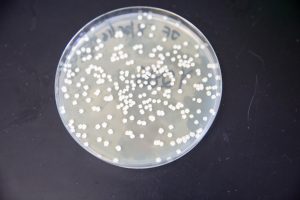A new innovative “super yeast” could very well improve the economics of ethanol production. A collaborative research team from the University of Wisconsin-Madison and the Great Lakes Bioenergy Research Center (GLBRC) have engineered a yeast strain that nearly doubles the efficiency of plant sugar to biofuel conversion.

Great Lakes Bioenergy Research Center researcher Trey Sato monitors yeast cultures in the lab. Sato and UW-Madison colleagues have engineered yeast to feast on a previously unpalatable sugar, potentially improving the microorganism’s ability to convert sugars to useful biofuels. Photo Credit: James Runde/Wisconsin Energy Institute
The team focused on the baker’s and brewer’s yeast Saccharomyces cerevisiae, a microbe highly adept at converting a plant’s glucose, or sugar, to biofuel. However, one challenge is that the yeast ignores the xylose found within the plant, a five-carbon sugar than can make up nearly half of all available plant sugars.
“For cellulosic biofuels to become economically feasible, microbes need to be able to convert all of a plant’s sugars, including xylose, into fuel,” explained Trey Sato, the GLBRC study’s lead researcher and a UW–Madison associate scientist.
In a study published in the journal PLOS Genetics, Sato and his GLBRC collaborators describe the isolation of specific genetic mutations that allow S. cerevisiae to convert xylose into ethanol. A finding, writes the researchers, that could transform xylose from a waste product into a source of fuel. To uncover these genetic mutations, the researchers had to untangle millions of years of evolution, teasing out what led S. cerevisiae to become so selective in the first place.
To begin, Sato and colleagues surrounding the yeast with xylose until it either reevaluated its distaste for xylose or died. It took 10 months and hundreds of generations of “directed evolution” for the team, including co-corresponding authors Robert Landick, a UW–Madison professor of biochemistry, and Audrey Gasch, a UW– Madison professor of genetics, to create a strain of S. cerevisiae that could ferment xylose.
Once the researchers had isolated the super yeast they named GLBRCY128, they then needed to learn exactly how the evolution had occurred as a mechanism for replication. Gasch compared Y128’s genome to the original strain, combing through the approximately 5,200 genes of each to find four gene mutations responsible for the adapted behavior. To verify their finding, the researchers manually deleted these mutations from the parent strain, producing the same result.

A culture plate with “super yeast,” engineered to feast on a previously unpalatable sugar, potentially improving the microorganism’s ability to convert sugars to useful biofuels. The new research was conducted at UW-Madison’s Great Lakes Bioenergy Research Center. Photo Credit: James Runde/Wisconsin Energy Institute
Sato said this work could enable a wide variety of biofuels research going forward. With the technique for making Y128 published, researchers are free to make it themselves for the purposes of applying it to new biomass pretreatment technologies or to different plant materials. “Scientists won’t need to adapt their research to the process that we’re doing here,” said Sato. “They can just take our technology and make their own strain.” Sato has said future research may also focus on the super yeast’s potentially powerful role in creating specialty biofuels and bioproducts.
“We want to take this strain and make higher-order molecules that can be further converted into jet fuels or something like isobutanol, lipids or diesel fuel,” added Sato. “And if we know how to better metabolize carbon, including xylose, anybody in theory should be able to rewire or change metabolic pathways to produce a variety of biofuel products.”

